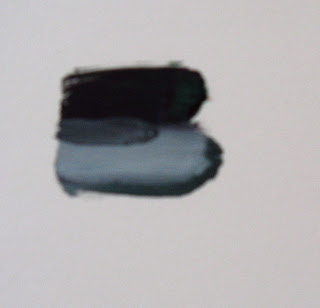Here we are back on edges, that important artist's tool often ignored in classes. Every brushstroke has four edges. It is rare that the stroke as laid down has all the right edges for your concept.
Two Brushstrokes with Edges, One Adjacent
Here you can see a hard edge separating the two brushstrokes. By chance the other edges are softer, but not extra soft. What if your squinting determines that the two strokes should have a soft edge? There are a number of ways to make that edge soft.
Lighten and Darken to Soften
Here the dark stroke has been lightened near the lighter stroke and the light stroke darkened near the dark stroke (small gradations). The edge between the strokes seems softer even though it isn't. So two adjacent strokes of close values will appear to have a soft edge between them.
An intermediate Brushstroke
Here a third stroke with an intermediate value is used to soften the edge between the two original brushstrokes. This can be done with a dry brush.
An intermediate Value/Colour
Here a third stroke with the appropriate value but in a different hue is used for softening.
Brush with Medium
Here a brush with a bit of medium is used (wet brush). Careful, one stroke. A different effect. A soft brush pulled between the two strokes looks like:
Dry Brush Softening
You can change directions, wiggle the brush, move the paint etc. If you want a different effect then;
Thumb, Palette Knife, Credit Card......
If not the universal painting tool, the thumb, then why not scrape with a palette knife or credit card? Hardening an edge to catch attention can be done with a brush.
Bristle Brush Hard Edge
And for even more emphasis try the knife.
Knife Edge, Crisp and Hard









No comments:
Post a Comment